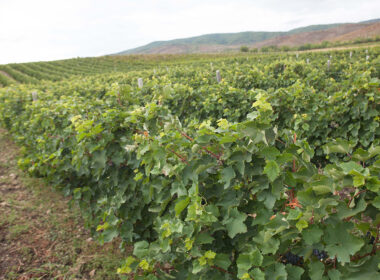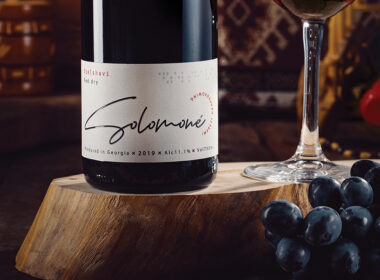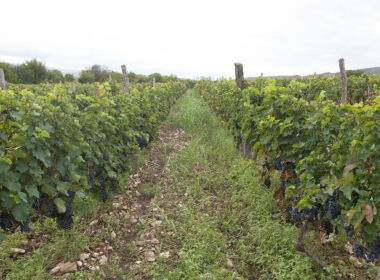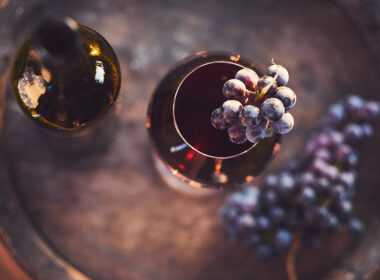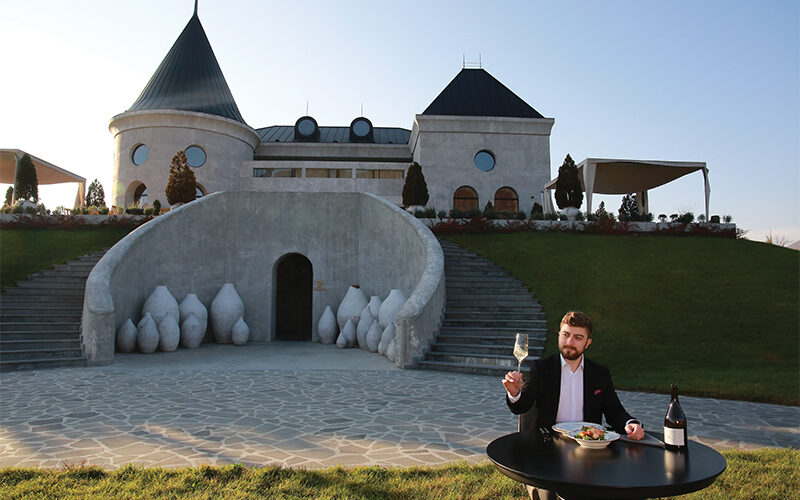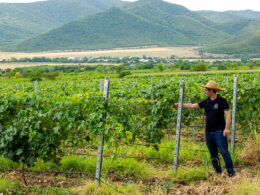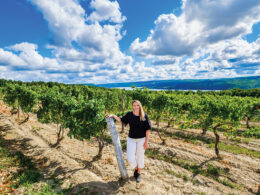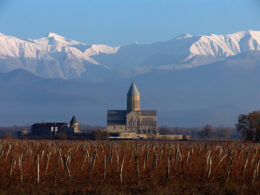Tazo Tamazashvili
The countries that pop up in our mind when we talk about sparkling wines are the countries of the Old World that have been producing them for a long time – France with its Champagne, Spain with Cava, and Italy with its Prosecco. Champaign is the youngest among French wines. The technology of its production is still undergoing refinement in Champaign, not to mention the experiments that the New World countries are conducting in relation to the classical Champaign method. The creation of Champaign is often attributed to a Benedictine monk Dom Pérignon, however, he was not the one who invented sparkling wines. The technology of making sparkling wines and the tradition of making these styles of wines, in general, go back to the Roman Empire. Having said that, France is largely responsible for the development and the refinement of these technologies, with Dom Pérignon inventing the method of sparkling wine bottling (creating the cork and cage). He was a great enthusiast that conducted numerous experiments, blending various grape varieties to get a unique product. As a result, France owns a magnificent sparkling wine, a big part of which was and is the climate. The region of Champagne is located in the North of France, where the climate is strict – with cold winters and frosty Springs. Chardonnay, Pinot Meunier, and Pinot Noire withstand these conditions, making them the staple of Champaign. Crémant is another wonderful French sparkling wine that is also made with traditional methods – secondary fermentation in a bottle and maturation on lees.
Spanish Cava is the second most known sparkling wine after Champaign. After the term “methode champenoise” was prohibited to be used on labels outside the region of Champaign, Cava became much more famous. Cava has a rich aroma, however is less complex and lacks the intensity and elegance of Champaign. Recommended varieties for Cava include Xarel-lo, Macabeo, and Parellada. And of course, there is Prosecco that is produced in Veneto and Friuli Venezia Giulia, from a famous grape variety – Glera. Italians are very proud of their accomplishments that are indeed brilliant in terms of technology.
There are numerous countries besides France, Spain, and Italy that produce sparkling wines.
High-class sparkling wines have a great aging potential in bottles; they can withstand 50-60 years and more. They might not have the same effervescence as the young Champaign, but they are well-developed and refined – the aromas develop into delicate notes such as black truffle, mineral, and spicy tones.
Sparkling wine is a lively beverage that awakens the mouth; it is light and bubbly. When the culture of this wine started forming in various countries, it was customary to drink it during celebrations. In time, the culture of consumption developed, increasing the production volumes and transforming sparkling wines into a gastronomical product of the world. This happened in large thanks to big producers: they accentuated the fact that sparkling wine was an ideal beverage when paired with certain dishes. This was quite a revolution. In the ’70s, the consumption of sparkling wines increased so much that they were included in restaurant menus as an aperitif that consumers could pair with different dishes. Sparkling wines also played an important role in the development of gastronomy in many countries. For instance, before pairing it with Champaign, sturgeon caviar was not that popular. Now, caviar and Champaign are a #1 classic pair.
Refined and lively acidity of sparkling wines (this acidity is precisely what gives the sparkling wines its vivacity) pair wonderfully with seafood. Acidity and saltiness are complementary components. Paired with salty dishes, sparkling wines become richer, with a longer and a more pleasant finish. Oysters, grilled prawns, mussels, or even fish tartar pairs beautifully with sparkling wine.
Sparkling wine culture in Georgia
Ivane Bagration of Mukhrani brought sparkling wines to Georgia in the 19th century. He was one of the first who traveled to the region of Champaign, tried sparkling wines, and decided to bring this style to Georgia as well. He conducted many important studies with wine technologists upon his arrival and discovered that the region of Kartli met sparkling wine standards with its location and Goruli Mtsvane, Chinebuli, and Tavkveri grape varieties. They yielded a lively wine, with pleasant aroma and acidity. Several documents and photos depict the production of sparkling wines in Mukhrani. Some celebratory occasions even had fountains of sparkling wine specially designed for guests and delegates. Today, “Chateau Mukhrani” plays a vital role in establishing Kartli as one of the wine-producing regions, as well as making characteristic, high-quality wines. I hope that their work will soon include the production of sparkling wines, especially from grapes from Ateni PDO.
Ateni (Atenuri) deserves a special mention, as Georgia’s only PDO dedicated to sparkling wine. During the Soviet era, a big production facility operated here but was closed due to many reasons. Subsequently, Ateni switched to producing regular wines. Sparkling wine produced in this region was made by blending some Georgian and French varieties registered there. The varieties included Chinebuli, also known as Chinuri, Goruli Mtsvane, Aligoté, and Pinot Noire. Surprisingly enough, Chardonnay was not on the list, even though Chardonnay was and is the only variety from Champaign that is used in assemblage and known for an exceptional Blanc De Blanc style wine. The same style can be achieved using Chinuri and Goruli Mtsvane, but it is still astonishing that the list of registered varieties did not use Chardonnay. As for Pinot Noire, this variety still grows in Georgia and gives great results in Karti terroirs, especially in Ateni, in both still and sparkling wines.
Pétillant Naturel
Natural wine emerged as a new trend in the world, and with it came the revival of Pét-Nats (Pétillant Naturel). Pet-Nat is a simpler, more natural, spontaneous sparkling wine: fermentation and maturation take place in a sealed bottle. This process does not create the same pressure as in Champaign or Prosecco, however, Pet-Nats are to be appreciated. These sparkling wines are lively, different, and pleasant. They have to be consumed while young, so the aromas and fizz reveal themselves to the fullest. Pet-Nat wines are very popular and desired in today’s world.
The classic method of making sparkling wines has several restrictions: for instance, it requires disgorging, no lees, a set percentage of red and white grape blends, etc. However, in the case of natural wines, experiments are not only acceptable but encouraged. This gives winemakers a certain kind of freedom to blend varieties and use grapes that have never before been used to make sparkling wines. Small producers, especially, benefit from this approach. They might not have the time or the resources to wait for a sparkling wine to age for 3-4 years. For them, this new trend is very comfortable and accessible.
The West of Georgia has an especially great potential in terms of Pet-Nats, due to its grape varieties and climate. Local varieties, such as Tsitska are best for making sparkling wines, as well as Tsolikouri, Krakhuna, Aladasturi, and Dselshavi. Racha is another region with great potential, since local varieties ripen later in the season, have thinner skin, and all other qualities necessary to produce high-quality sparkling wines. Aleksandrouli is an especially interesting variety that can be compared with Pinot Noir from Burgundy and Champaign. For now, Pet-Nat production from Aleksandrouli and its tasting are in an experimental stage, but one thing is certain – this variety has the potential to be used for making rosé Pet-Nats, as well as sparkling wine. White grapes, such as Rachuli Tetra, Rachuli Mtsvane, or even Rachuli Tsolikouri blend can also give interesting results.
There is an ideal variety in Guria, called Chkhaveri. It can be used to make both white and rose sparkling wines. It would be interesting to try Pet-Nats made from Megrelian Ojaleshi, Chkhaveri from Guria, as well as Chkhaveri from the mountains of Adjara (this variety is completely different in this region and is ideal for sparkling wines). The same goes for Abkhazia with 51 endemic varieties, most of which are great for making subtropic sparkling wines. There is a long way ahead. I believe we can surprise the world.
As a rule, no one orders red wine at the start of their dinner or supper. This prerogative belongs to sparkling wine. It is a sort of a “Gamarjoba” (greeting, in Georgian) of the restaurant. Georgia should greet the world (say “Gamarjoba”) with its sparkling wines.
The pairing of Georgian sparkling wine and Pet-Nats with food

Tiger prawns in honey and hazelnut sauce, with buffalo cheese and arugula. We combined this dish with “sparkling wine from “Chateau Buera”, made with Chineburi and Tsitka grape varieties from Kartli and Imereti. This wine is rich with lively aromas – in this case, citrus and green apples – that are characteristic of young sparkling wines made with traditional methods. Aromas are complemented with lasting mineral tones that go so well with seafood dishes. Prawns and sparkling wine form an ideal balance since the acidity of the wine and sweet and savory tones of prawns complement each other very well.
This sparkling wine can also be successfully paired with oysters, mussels, and other seafood dishes, such as mussels in white wine sauce or fish that have a pleasant saltiness and refined and solid taste.
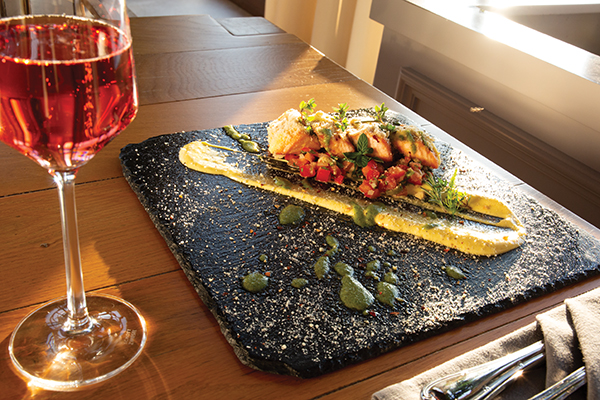
Duck with vegetables, in citrus and tarragon sauce, is a great example of vibrant aromas. Red duck meat is soft and aromatic. Both still and sparkling wines pair beautifully with this meat. The citrus sauce brings the dish to life, adding cheerfulness and acidity to it, enriching the flavor, which pairs well with Pet-Nats from Aladasturi, Imereti region.
As a result of the fermentation in the bottle, Gvantsa’s Aladasturi Rosé Pet-Nat (“Gvanta’s wine”) has vibrant berry tones, such as raspberry, strawberry, as well as citrus tones – lime zest, a slight orange tone. It makes a great pair of duck meat and a citrus sauce. Aladasturi Pet-Nat being pink, and the duck meat being red makes this combination structurally sound, without one component overpowering the other.
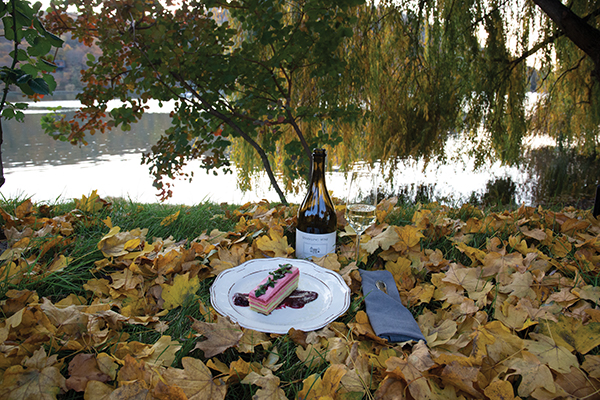
Berry and pistachio cake and sparkling wine. As a rule, sweet components should inevitably be combined with other sweets. Much like a still wine, sparkling wine has its classification: dry, semi-dry, sweet, and semi-sweet. Saperavi reduction gives this berry and pistachio cake a pleasant liquor taste with slight hints of chocolate. Such a dessert should be paired with sweet or semi-sweet sparkling wines, such as, “Elisabeth” from “Chateau Ateni”, made with Chinuri, Tavkveri, and Goruli Mtsvane grapes. Its berry aromas make it a great partner to the sweet components of our dessert. We can also pair it with white or pink semi-sweet sparkling wine from “Telavi Wine Cellar”.
I’d like to see sommeliers and winemakers conducting more experiments and increasing the awareness of Georgian sparkling wines. We should strive to make correct and interesting pairings with Georgian dishes – the starters, main dishes, and desserts. If Champaign could promote Champaign pairing with caviar, oysters, and other seafood, and establish it as a restaurant stable, so can we promote Georgian cuisine by pairing it with our sparkling wines. We must find and hold our place in the style of sparkling wines. This could be our “Gamarjoba”.

